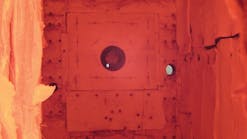Optimization of boiler systems to achieve efficiency ratings always has been easier said than done. That is changing, however, thanks to advanced technologies such as onboard sensors and optional remote-monitoring services.
Remote-monitoring systems utilize advanced software and secure Ethernet connections to detect the slightest variations in boiler performance and communicate them to factory engineers at a centralized hub. Previously, factory engineers and field technicians had to assume boilers were performing to specifications, as there were no tools for tracking performance. Now, factory engineers and facility managers can analyze system data in real time and manually adjust boilers to achieve peak efficiency or to nip service issues in the bud. With remote-monitoring technology, factory engineers and facility-management personnel receive e-mail alerts of potential problems in time to keep them from becoming costly repairs. This helps to improve uptime reliability and extend equipment life.
Monitoring performance and efficiency upon startup and throughout the life of a boiler system has tremendous value to facility managers, owners, and energy-service companies.
Collecting Valuable Data
A remote-monitoring system usually is designed within a boiler controller, allowing easy integration with facility-management systems.
A simple, reliable, and affordable installation involves running an Ethernet line from a local-area-network connection on each boiler to the mechanical room. The remote-monitoring system was designed with network-management and information-technology-security-professional input and does not require a static Internet Protocol address or any changes to a firewall or inbound connections. It strictly is a one-way secure operation in which data is sent directly to a remote-monitoring hub. Data packets are small (less than 2 KB), with transfer rates of less than 1,000 bytes, which ensures the data stream does not affect the facility’s network performance.
A key advantage of remote-monitoring systems is that they provide internal monitoring and “performance intelligence” based on algorithms customized for specific units. Three types of analysis are performed:
• Heartbeat data. Key performance indicators and diagnostic information, such as run cycle, temperature control, exhaust temperature, oxygen, and flame strength, are monitored 24/7/365 and can be leveraged to make adjustments to maximize system performance.
• Setup configuration. A key to achieving the best possible performance is properly configuring a boiler during installation. A monitoring system checks setpoint, operating modes, safety limits, and other data to ensure continuous optimum operation.
• Event data. A remote-monitoring system can compile and store trending and historical data, allowing an engineering team to identify potential system problems and offer corrective measures to avoid catastrophic events and ensure system uptime.
Efficiency Data and Real-Time Early Warning Notifications via E-mail
A remote-monitoring system can generate graphic interpretations of boiler performance and key indicators. Engineers then can analyze the data and calibrate the boiler for optimum performance or uncover efficiency problems stemming from incorrect installation.
A remote-monitoring system is configured to send an automated message with recommendations as to improving performance every two weeks and can serve as an early warning system that will alert the engineering team of impending problems. In performance-calibration mode, remote-monitoring systems detect slight variations in boiler operation and offer corrective measures that reduce operating costs in two key ways:
• Optimum system performance: Even the most diligent facility manager may not be able to conduct recommended scheduled maintenance according to best practices. Remote-monitoring systems will send alerts notifying facility managers of declining performance that often can be corrected via a simple calibration prior to regular maintenance. This restores the system to optimum levels and helps to ensure long boiler life.
• System downtime: Ongoing monitoring is proactive and can help to prevent unscheduled reactive maintenance, as well as the associated high cost of repairing a boiler system. Proactive remote monitoring reduces system downtime, which can result in lost revenue that never can be recouped.
New Technology That Enhances Profitability and Uptime Reliability
Remote-monitoring systems can help to reduce operating costs and improve system reliability in any facility. In particular, their advantages are realized in buildings where downtime can be extremely costly. Two such examples are hotels, where guests may have to be sent to another location or check out early, and multifamily apartment buildings, in which tenants can withhold rent because of non-functioning HVAC systems that render apartments uninhabitable.
Summary
Maintaining high-efficiency boiler operations can reduce costs while helping to maintain a smaller carbon footprint. Installing boilers with remote-monitoring systems gives engineers greater confidence their designs will deliver robust reliability and the high efficiency facility owners expect to reduce operating expense, maximize revenue generation, and ensure occupant satisfaction. Additionally, the 24/7/365 monitoring reports generated by the systems allow facility managers to proactively analyze, calibrate, and implement preventive maintenance that extends equipment life in addition to optimizing system performance and efficiency.
As director of product solutions and training for AERCO International, Peter Rimassa is responsible for managing the production-solutions team for new product-development initiatives and expanding the scope of AERCO’s training programs to include mobile training trucks and regional training centers in North America. He holds a bachelor’s degree in mechanical engineering and a master’s degree in business administration from the New Jersey Institute of Technology.
Did you find this article useful? Send comments and suggestions to Executive Editor Scott Arnold at [email protected].









